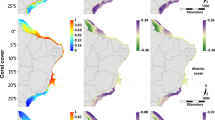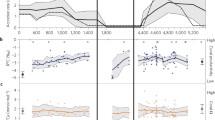Abstract
Marginal reef habitats are regarded as regions where coral reefs and coral communities reflect the effects of steady-state or long-term average environmental limitations. We used classifications based on this concept with predicted time-variant conditions of future climate to develop a scenario for the evolution of future marginality. Model results based on a conservative scenario of atmospheric CO2 increase were used to examine changes in sea surface temperature and aragonite saturation state over the Pacific Ocean basin until 2069. Results of the projections indicated that essentially all reef locations are likely to become marginal with respect to aragonite saturation state. Significant areas, including some with the highest biodiversity, are expected to experience high-temperature regimes that may be marginal, and additional areas will enter the borderline high temperature range that have experienced significant ENSO-related bleaching in the recent past. The positive effects of warming in areas that are presently marginal in terms of low temperature were limited. Conditions of the late 21st century do not lie outside the ranges in which present-day marginal reef systems occur. Adaptive and acclimative capabilities of organisms and communities will be critical in determining the future of coral reef ecosystems.



Similar content being viewed by others
References
Boville BA, Gent PR (1998) The NCAR climate system model, version one. J Clim 11:1115–1130
Buddemeier RW (2001) Is it time to give up? Bull Mar Sci 69:20–29
Buddemeier RW, Fautin DG (2002) Overview—large-scale dynamics: the state of the science, the state of the reefs, and the research issues. Coral Reefs 21:1–8
Buddemeier RW, Smith SV (1999) Coral adaptation and acclimatization: a most ingenious paradox. Am Zool 39:1–9
Collins WD, Bucholtz A, Lubin D, Flatau P, Valero FPJ, Weaver CP, Pilewski P (2000) Determination of surface heating by convective cloud systems in the central equatorial Pacific from surface and satellite measurements. J Geophys Res 105:14807–14821
Done TJ (1999) Coral community adaptability to environmental change at the scales of regions, reefs and reef zones. Am Zool 39:66–79
Enfield DB (2001) Evolution and historical perspective of the 1997–1998 El Niño-Southern Oscillation event. Bull Mar Sci 69:7–25
Gates RD, Edmunds PJ (1999) The physiological mechanisms of acclimatization in tropical reef corals. Am Zool 39:30–43
Gattuso J-P, Buddemeier RW (2001) Coral reefs: an ecosystem subject to multiple environmental threats. In: Mooney HA, Canadell J (eds) The earth system: biological and ecological dimensions of global environmental change, vol 2. Wiley, Chichester, pp 232–241
Gattuso J-P, Allemand D, Frankignoulle M (1999) Photosynthesis and calcification at cellular, organismal and community levels in coral reefs: a review on interactions and control by the carbonate chemistry. Am Zool 39:160–183
Guinotte JM (1999) A model for predicting coral reef habitat in the tropical western Atlantic and eastern Pacific. Master’s Thesis, Kansas State University, Manhattan, Kansas
Halley RB, Yates KK (2000) Will reef sediments bugger corals from increased global CO2? In: Proc 9th Int Coral Reef Symp, Bali, Indonesia, 23–27 Oct, Abstr
Harriott VJ, Banks SA (2002) Latitudinal variation in coral communities in eastern Australia: a qualitative biophysical model of factors regulating coral reefs. Coral Reefs 21:83–94
Jokiel PL, Coles SL (1990) Response of Hawaiian and other Indo-Pacific reef corals to elevated temperature. Coral Reefs 8:155–162
Kennedy VS, Twilley RR, Kleypas JA, Cowan JHJ Jr, Hare SR (2002) Coastal and marine ecosystems and global climate change. Potential effects on US resources. Pew Center on Global Climate Change, Arlington, Virginia, 52 pp
Kleypas JA (1997) Modeled estimates of global reef habitat and carbonate production since the last glacial maximum. Paleoceanography 12:533–545
Kleypas JA, Buddemeier RW, Archer D, Gattuso J-P, Langdon C, Opdyke BN (1999a) Geochemical consequences of increased atmospheric carbon dioxide on coral reefs. Science 284:118–120
Kleypas JA, McManus JW, Meñez LAB (1999b) Environmental limits to coral reef development: where do we draw the line? Am Zool 39:146–159
Kleypas JA, Buddemeier RW, Gattuso J-P (2001) Defining ‘coral reef’ for the age of global change. Int J Earth Sci 90:426–437
Langdon C (2003) Overview of experimental evidence for effects of CO2 on calcification of reef builders. In: Proc 9th Int Coral Reef Symp, Bali, Indonesia, 23–27 Oct
Li T, Hogan TF, Chang CP (2000) Dynamic and thermodynamic regulation of ocean warming. J Atmos Sci 57:3353–3365
Loschnigg J, Webster PJ (2000) A coupled ocean–atmosphere system of SST modulation for the Indian Ocean. J Clim 13:3342–3360
Nakicenovic N, Swart R (2000) IPCC special report on emissions scenarios (SRES). Intergovernmental Panel on Climate Change, Geneva
Ninio R, Meekan MJ (2002) Spatial patterns in benthic communities and the dynamics of a mosaic ecosystem on the Great Barrier Reef, Australia. Coral Reefs 21:95–103
Ramanathan V, Collins W (1991) Thermodynamic regulation of ocean warming by cirrus clouds deduced from observations of the 1987 El Niño. Nature 351:27–32
Reynolds RW, Rayner NA, Smith TM, Stokes DC, Wang W (2002) An improved in situ and satellite SST analysis for climate. J Clim 15:1609–1625
Roberts CM, McClean CJ, Veron JEN, Hawkins JP, Allen GR, McAllister DE, Mittermeier CG, Schueler FW, Spalding M, Wells F, Vynne C, Werner TB (2002) Marine biodiversity hotspots and conservation priorities for tropical reefs. Science 295:1280–1284
Smith SV, Buddemeier RW (1992) Global change and coral reef ecosystems. Annu Rev Ecol System 23:89–118
Steffen W, Tyson P (2001) Global change and the earth system: a planet under pressure. International Geosphere–Biosphere Programme, Stockholm, 36 pp
Veron JEN (1995) Corals in space and time. UNSW Press, Sydney
Wilkinson C (2000) Status of coral reefs of the world (2000). Global Coral Reef Monitoring Network and Australian Institute of Marine Science, Townsville, Australia
Wood R (1999) Reef evolution. Oxford University Press, Oxford
Acknowledgements
Aspects of the work contributing to this paper have been supported by US National Science Foundation Project OCE 00-03970 “Biogeoinformatics of the Hexacorallia” and by the Land–Ocean Interactions in the Coastal Zone (LOICZ) core project of the International Geosphere–Biosphere Programme (IGBP). The National Coral Reef Institute (NCRI) supported initial developments of this approach. The Australian government, James Cook University’s Tropical Environment Science and Geography (TESAG) Department, and the Australian Institute of Marine Science (AIMS) have supported John Guinotte’s PhD research in the form of scholarships, stipends, and logistical support (International Postgraduate Research Scholarship and JCU TESAG stipend); this paper is a component of his doctoral dissertation research. We are grateful to Susan White and James Maragos of the US Fish and Wildlife Service for information on the Pacific Island National Wildlife Refuges, and to Mark Schoneweis for assistance with preparing the figures.
Author information
Authors and Affiliations
Corresponding author
Electronic Supplementary Material
Rights and permissions
About this article
Cite this article
Guinotte, J.M., Buddemeier, R.W. & Kleypas, J.A. Future coral reef habitat marginality: temporal and spatial effects of climate change in the Pacific basin. Coral Reefs 22, 551–558 (2003). https://doi.org/10.1007/s00338-003-0331-4
Received:
Accepted:
Published:
Issue Date:
DOI: https://doi.org/10.1007/s00338-003-0331-4




